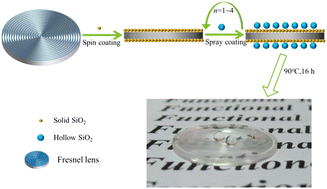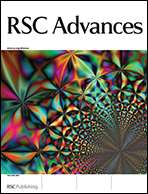Superhydrophobic self-cleaning antireflective coatings on Fresnel lenses by integrating hydrophilic solid and hydrophobic hollow silica nanoparticles†
Abstract
Superhydrophobic self-cleaning antireflective coatings were fabricated on Fresnel lenses by integrating solid silica nanoparticles (SSNs) and stearic acid (STA) and 1H,1H,2H,2H-perflurooctyltriethoxysilane (POTS) co-modified hollow silica nanoparticles (SPHSNs) via spin- and spray-assembly without any high temperature pre- or post-treatment. Transmission electron microscopy (TEM) was used to observe the morphology and structure of nanoparticles. Transmission spectra were recorded using a UV-Vis-NIR spectrophotometer. Surface wettability was studied by an automatic contact angle/interface system. Condensation performance of the Fresnel lenses was studied by measuring the focal length and the powers before and after being focused. The (SSNs)1/(SPHSNs)2 coating turned out to simultaneously demonstrate excellent superhydrophobic self-cleaning and antireflective properties, which has a maximum transmittance of 99.0% and average transmittance of 98.5% in the wavelength range of 400–800 nm, and the condensing efficiency of the coated Fresnel lens has also been significantly improved. The surface morphology and structure of coatings were examined by scanning electron microscopy (SEM) and atomic force microscopy (AFM). The effects of surface morphology and structure on the optical and wetting properties of coatings were also discussed. The density of SPHSNs on the coating surface was considered to significantly influence both the light transmission and hydrophobicity of coated Fresnel lenses.


 Please wait while we load your content...
Please wait while we load your content...